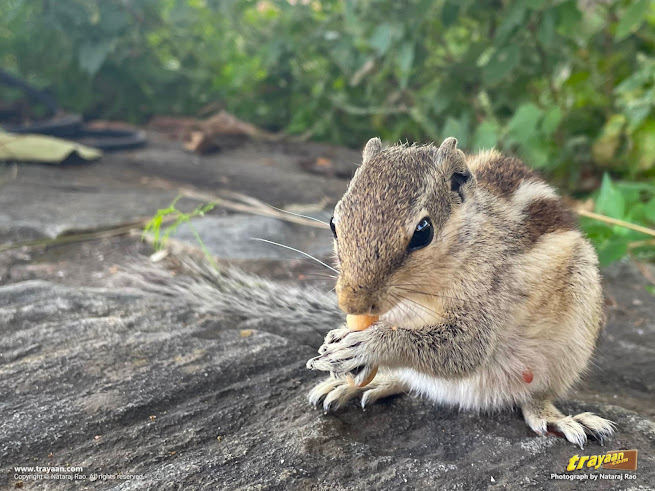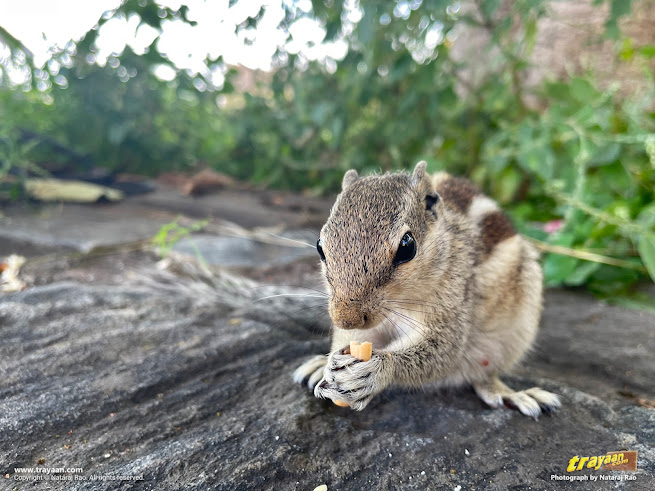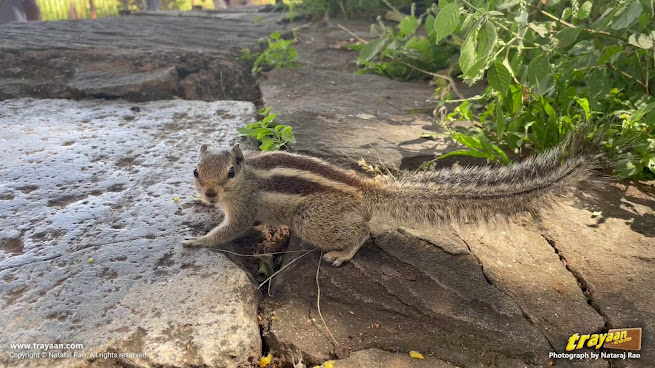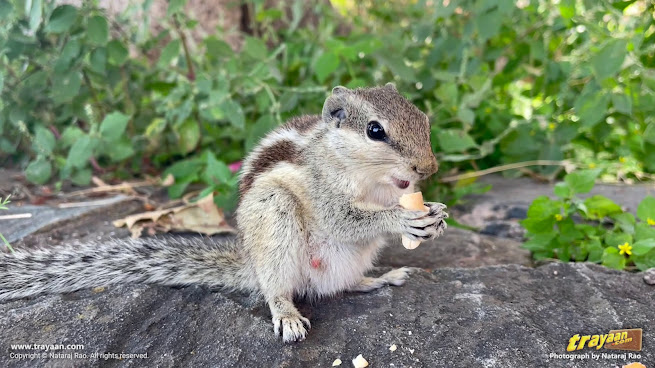Some more cute little joys of travelling, in pictures, and a Ramayana tale of how Indian squirrels got their stripes.
I spotted this nice little squirrel near Gingee fort while passing by that place recently. It reminded me of the squirrels of Minnesota I had seen some years ago.
As I've mentioned before, although I go for the big things, I also take time to look at the little things -- the little creatures at any place that give me great joys, may it be anywhere, anytime.
Which brings us to our little friend here, a squirrel we found near the fort in Gingee, with whom we spent a little quality time as it enjoyed some snacks.
This is a typical Indian palm squirrel, and in addition to the video above, we'll see some more pictures of our little friend below.
About our little squirrel friend at Gingee
During a brief stop at Gingee, in Viluppuram district of Tamil Nadu, this little squirrel grabbed my attention.
It's a common Indian palm squirrel, and as evident from the pictures below and video above, this one's a female.
Unlike the Eastern Gray Squirrels in Minnesota, this rodent here was comparatively more shy and likes to keep more distance. So, after taking a few pics and a couple of short video clips, I left it alone to enjoy its snack and went on my way.
Although these squirrels may look like chipmunks, they're not exactly the same, even though they both belong to the squirrel family. The difference is that chipmunks are ground squirrels which live on the ground or in burrows, unlike our tree squirrels here.
Chipmunks are native to regions of North America and Siberia. But they sure look similar in appearance, with distinctive stripes on the backs on both of these species.
About the Indian palm squirrel
As you can see from the pictures and video, the Indian palm squirrel has three distinct white stripes on a darker section of fur which runs from its back to its tail. A similar type of palm squirrel in India has five stripes instead of three, which is called as the northern palm squirrel.
These squirrels are found across India, even on the trees near your house, and as the name suggests, especially on palm trees.
Funambulus palmarum, the Indian Palm Squirrel, is the State Animal of Puducherry[1]. Puducherry is a coastal Union Territory of India adjacent to Tamil Nadu. Until 1954, it was a former French colony, and was known as Pondicherry - its French version of name, until it was finally renamed to its original Tamil name Puducherry, in 2006.[2]
As per the Wildlife (Protection) Act of 1972, squirrel was placed under schedule IV and considered as endangered, which is why it was declared as the State Animal of Puducherry.[1]
Coincidentally, I was on my way to Puducherry, while I briefly stopped here at Gingee. Depending on the road you take, Puducherry is about 63 to 70 kilometres from Gingee.
Indian palm squirrels are mammals of the genus funambulus and consist of five distinct species. The two most abundant and best-known Indian palm squirrel species, F. pennantii and F. palmarum come in size from 225–400 mm total length (including 110–120 mm long tail).[3]
All species of Indian Palm Squirrel have at least three stripes, but F. pennantii (a.k.a. northern palm squirrel) has two additional paler stripes on its sides, running between their hind legs and forelegs.[3]
The eastern grey squirrels that I saw in America are different from our typical lined squirrels back home in India. As you may have seen from my pictures of them, they look different and do not have the distinct stripes on their back that Indian squirrels do.
However, not all squirrel species in Indian subcontinent have stripes on their back. There are some other types of squirrels, other than the Indian Palm Squirrels, which do not have these distinctive stripes.
The Indian giant squirrels, which are multicoloured but mainly reddish-brown or maroon in colour, do not have any stripes on their backs. Also, the black giant squirrel found in Northeast India, doesn't have these stripes either. Another squirrel without such stripes and found in India, is the Grizzled Giant Squirrel.
But unlike the regular striped palm squirrels which can be found in urban or rural areas of cities and towns, the large squirrels without stripes live in the jungles or forest areas.
Now, it is well known that our typical striped Indian squirrels have stripes on their backs, and so do Asiatic striped squirrels which are found in parts of China, Thailand, Laos, Malaysia, etc., for that matter. They have some differences in the stripe patterns, however.
But it is not known why exactly do they have these stripes, that is, why did they evolve these stripes and what was the evolutionary advantage or purpose behind it. Bright stripes wouldn't be much helpful if they attract predators, so how or why they have it, remains a mystery scientifically.
However, outside of science, there is a tale from the very ancient Indian epic the Ramayana about how and why Indian squirrels got those stripes on their back, which most of you would know already, in which case, you may skip the tale below and go to the end of this article.
And for those of you who do not know and are interested to know it, here's the tale below, and I present it here as it is a part of India's rich cultural heritage and an ancient wisdom which is evergreen.
The tale of Shri Rama and the Squirrel
How squirrels got the stripes on their back, according to Ramayana :
It is said that this squirrel story doesn't appear in the original Ramayana by Maharshi Valmiki. However, this story is very popular, especially in southern parts of India, and it appears in some versions of Ramayana.
It is known to appear in Ranganatha Ramayanam, a 14th century Telugu version, but however, this squirrel story in a Ramayana version is much older, as Thondaradippodi Alwar who existed not later than 8th Century CE, speaks about it in one of his Tamil poems.[4]
Below I give a brief account of this famous Ramayana tale, as I remember it.
As this story of Ramayana goes, Shri Rama, the eldest son of King Dashratha and Queen Kaushalya, was forced into a 14-year exile in the jungles and was accompanied by his wife, Seetha, and brother, Lakshmana, who went along with him in this vanawasa. During this exile, the evil King Ravana abducted Sita and took her to his impregnable kingdom of Lanka, which is an island across the sea from around Indian subcontinent's southernmost part.
Shri Raama, determined to rescue Sita, reached the ocean’s edge with the help of the Vanara army led by Sugriva and Hanuman, and was accompanied by Jambawanta the bear king. However, it was advised against crossing the sea with the army in boats, as they could've been easily destroyed by Lanka's defences by the shores; and there was no other way to cross the ocean. Rama sat in meditation, requesting the Ocean God or Varuna Deva (the God associated with the sky, oceans, and water) to part the waters so they could proceed.
But despite his prayers, the sea remained unmoved and his prayers unanswered. An angered Shri Rama picked up his bow and aimed an arrow at the ocean, threatening to dry it up. The Sea God, realising the consequences, appeared before Shri Ram and explained that he couldn’t defy the laws of nature and part the waters of the sea.
However, he offered a solution that he would allow a bridge to be built over the ocean and Rama’s army could pass on it. To construct this bridge to Lanka, the Vanaras brought large boulders and stones, and after writing Shri Ram on them, put them in the sea to make a bridge to the island of Lanka.
A squirrel was watching everything happening by the shore. It observed the Vanaras bringing boulders and rocks for the bridge and putting them in the sea. Feeling a sense of duty and devotion to Shri Rama and his cause, the squirrel decided to contribute. It began picking up sand, small pebbles, and twigs from the shore and began putting them on the boulders and stones, and also rolled in the sand and shook it off over the stones.
The Vanaras were angry and shouted at the squirrel, telling it to go away saying it was disturbing their work by running around between them.
The squirrel insisted in helping, saying that it is also helping them build the bridge. But the Vanaras began to laugh and mock the poor squirrel who was only trying to help.
Of course, the squirrel’s efforts were minuscule compared to the massive rocks carried by the Vanara, but it worked tirelessly. Shri Rama noticed the little creature’s dedication and the commotion going on, and he approached the Vanara and told them that no effort is big or small, and everyone must do their work depending upon their own capacity.
Shri Rama also explains the importance of teamwork and that everyone in the team is important, as the final goal of a team can be achieved through collective contribution of all members, irrespective of how big or small they are. Shri Rama said that the small pebbles and sand carried by the squirrel or small creatures can fill the gaps between the large rocks and boulders and help bind them, thus contributing to strengthen the bridge.
Shri Rama then thanks the little squirrel for its service and gently strokes its back, leaving white stripes on its back — the marks of Shri Rama’s touch, which was forever imprinted on the squirrel. If I'm not mistaken, the squirrel is joined by more squirrels and other creatures to help build this bridge.
The squirrel became a symbol of selfless service and devotion, and the saying "a squirrel's service" became famous across the subcontinent since ancient times.
This is a great tale that tells the importance of hard work, dedication, and doing whatever is in your capacity, along with the importance of teamwork and the recognition and acknowledgement of the efforts of all the team members, no matter how big or small they be, and that it is totally wrong to belittle anyone who works or contributes sincerely with genuine efforts and dedication.
Shri Rama Sethu, or Shri Rama’s bridge, built with the combined efforts of Vanaras and little creatures, finally leads them to Lanka, and they defeat the villain Ravana's army and the story ends with Shri Rama killing Ravana and rescuing Sita, and Shri Rama, Lakshmana, and Sita, returning to Ayodhya.
The tale of Shri Rama and the Squirrel teaches us that no act of kindness or service is insignificant. Every effort counts, and even a small contribution done with dedication can contribute to a greater purpose.
So, that's the little tale of the little squirrel and how it got its stripes, according to a version of the Indian epic Ramayana.
Location Map of Gingee Fort
There are two forts at Gingee. Zoom in/out of the above map to explore. Gingee Fort was inscribed as a UNESCO World Heritage Site as a part of Maratha Military Landscapes of India, on 11 July 2025.
Coming back to Gingee, the squirrel here was a little one but it certainly brought great joy to me.
And that's all for now, see you next time with something new. Happy travelling!
- State Animal of Puducherry (Squirrel) - ENVIS Newsletter, Volume-VIII-II April – June - 2017. Department of Science, Technology and Environment - Puducherry. Retrieved 03 March 2024.
- Pondicherry renamed as Puducherry - News18. Last Updated: September 20, 2006, 16:13 IST. Retrieved 03 March 2024.
- Indian Palm Squirrel - Department of Primary Industries, Govt. of Australia. Retrieved 03 March 2024.
- Sri Rama and squirrel.. where did this story originate? - Hinduism Stack Exchange. Dec 25, 2017.













